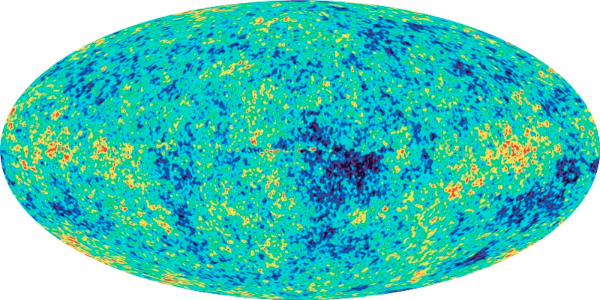
What force generated the cosmic explosion of the Big Bang's early moments?
It was in seeking to answer this question that scientists came up with the idea of a multiverse. The first moments of the Big Bang would have obeyed a phenomenal force, a repulsive gravity, a kind of reverse gravitation.
In 1979, physicist Alan Guth (1947-) named the short phase of original expansion Inflation. Inflation would have arisen from gravitational repulsion; this repulsion of inflation would be the bang of the Big Bang.
Already in 1992, the COBE satellite had transmitted a first image of this inflation. In 2003, with the WMAP satellite, the imprint of inflation confirmed its existence with very high resolution. The temperature variations observed by COBE match the predictions of the theory of inflation. These equations reveal another prediction that Russian physicists Andrei Dmitrievich Linde (1948-) and Alexander Vilenkin (1949-) would discover. Our Observable Universe would not be unique.
They imagine an astonishing scenario where inflation has ended in some regions but continues in others. New Big Bangs would occur continuously, giving birth to ever more numerous universes. This revolutionary concept does not have unanimous support because it is impossible to detect. However, other clues will shed light on the concept of the multiverse.
We know that the Universe is expanding and that its expansion is not slowing down but accelerating. What is this force that pushes all galaxies away from each other at an increasingly rapid pace?
Scientists call it Dark Energy. They will even discover the very particular value of this energy. It would have a magnitude written with a 0, followed by 122 zeros before the number one. This extremely small value, much lower than predicted by the equations, explains why the matter in our universe exists. If we remove only 3 or 4 zeros, which is very little, the acceleration would be so fast that matter could not organize itself to form stars and galaxies. In this concept, each value of dark energy represents a different universe.
With string theory, another clue emerges. Strings are vibrating particles that, depending on their vibrations, give rise to different subatomic particles. String theory only works if there are additional spatial dimensions, but the more we study these additional spatial dimensions, the more we discover, reaching the figure of 10,500. This seems far-fetched, but string theory describes a multitude of solutions, each corresponding to a possible universe, a universe where the amount of dark energy would be different each time.
Eternal inflation, dark energy, and string theory converge towards the existence of a multiverse where all universes would be different in appearance but endowed with unimaginable properties. Some would have neither light nor matter, but since the possibilities are infinite (10,500), there must be one that could resemble ours, leading science fiction enthusiasts to say that there is an exact copy of our universe, that we all have a double living in a cosmic bubble.
Until we see these bubbles, any speculation is possible. However, until today, mathematics has often shown us the existence of entities long before we observed them.
The universe is a cosmic bubble in an ever-expanding Cosmos. This bubble creates a new bubble that will produce others. Universes giving birth to other universes is an interesting idea but remains speculative.
If we observe the universe as we know it, it is primarily because we are in it. This is known as the Anthropic Principle, an epistemological principle stating that observations of the Universe must be compatible with the presence of an observer. But any theory that includes our existence must necessarily be consistent with our own existence. Thus, the development of the universe must be ordered to explain our own appearance. The most astonishing thing is that our Universe has evolved in such a way as to allow conscious entities to appear to notice it. Consequently, from our point of view (conscious entity in the universe), our universe is just one of the multiple universes that could have existed, and there is nothing improbable about other universes existing.
However, our Universe is unique since we cannot compare it to others. The field of physics is limited to the domain of experimentation; beyond that, it is metaphysics.